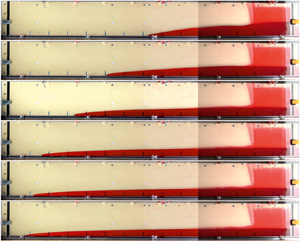Published online by Cambridge University Press: 05 May 2021

We study non-Newtonian effects associated with power-law rheology of behaviour index  $n$ on the propagation of horizontal gravity currents. Two different set-ups are examined: (i) converging flow toward the origin in a channel of gap thickness
$n$ on the propagation of horizontal gravity currents. Two different set-ups are examined: (i) converging flow toward the origin in a channel of gap thickness  $b(x) \propto x^k$ and
$b(x) \propto x^k$ and  $k<1$ and (ii) converging flow along
$k<1$ and (ii) converging flow along  $r$ toward the centre in a cylinder. The front of the current propagates in the negative
$r$ toward the centre in a cylinder. The front of the current propagates in the negative  $x$ or
$x$ or  $r$ direction reaching the origin in a finite touch-down time
$r$ direction reaching the origin in a finite touch-down time  $t_c$ during the pre-closure phase; in the post-closure phase, the current flows back in the positive direction and progressively levels out. Under the classical viscous-buoyancy balance, the current propagation is described by a differential problem amenable to a self-similar solution of the second-kind coupling space and reduced time
$t_c$ during the pre-closure phase; in the post-closure phase, the current flows back in the positive direction and progressively levels out. Under the classical viscous-buoyancy balance, the current propagation is described by a differential problem amenable to a self-similar solution of the second-kind coupling space and reduced time  $t_r=t_c-t$. The problem formulation in the phase plane leads to an autonomous system of differential equations which requires numerical integration and yields the shape of the current and its front as
$t_r=t_c-t$. The problem formulation in the phase plane leads to an autonomous system of differential equations which requires numerical integration and yields the shape of the current and its front as  $\xi _f\propto t_r^{\delta _c}$,
$\xi _f\propto t_r^{\delta _c}$,  $\xi _f$ being the self-similar variable value at the front and
$\xi _f$ being the self-similar variable value at the front and  $\delta _c$ being the critical eigenvalue. The latter is a function of fluid rheology
$\delta _c$ being the critical eigenvalue. The latter is a function of fluid rheology  $n$ and of channel geometry
$n$ and of channel geometry  $k$ for the first set-up; it is a function only of
$k$ for the first set-up; it is a function only of  $n$ for the second set-up. The dependency on
$n$ for the second set-up. The dependency on  $n$ is modest. The theoretical formulation is validated through experiments conducted during both pre- and post-closure phases and aimed at measuring the front position and the profile of the current. Experimental results are in fairly good agreement with theory and allow quantitative determination of the time interval of validity of the intermediate asymptotics regime, when self-similarity is achieved and when it is lost.
$n$ is modest. The theoretical formulation is validated through experiments conducted during both pre- and post-closure phases and aimed at measuring the front position and the profile of the current. Experimental results are in fairly good agreement with theory and allow quantitative determination of the time interval of validity of the intermediate asymptotics regime, when self-similarity is achieved and when it is lost.